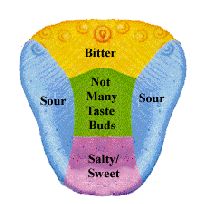
|
Some Common Myths Thought to be True - Myth 69
Myth 69: Tastes are Detected by Certain Parts of the Tongue
The tongue map or taste map is a common misconception that different sections
of the tongue are exclusively responsible for different basic tastes. It is
illustrated with a schematic map of the tongue, with certain parts of the
tongue labeled for each taste. Although widely taught in schools, this was
scientifically disproven by later research; all taste sensations come from all
regions of the tongue, although parts may be more sensitive to certain
flavors.
|
| Tongue Taste Buds Map | |
|
Actually, the paper showed minute differences in threshold detection levels
across the tongue. These differences were later taken out of context and the
minute difference in threshold sensitivity related simply in textbooks as a
difference in sensitivity.
|
|
| ⇦ Back to Myth 68 Return to Myth Choices Page 5 On to Myth 70 ⇨ | |